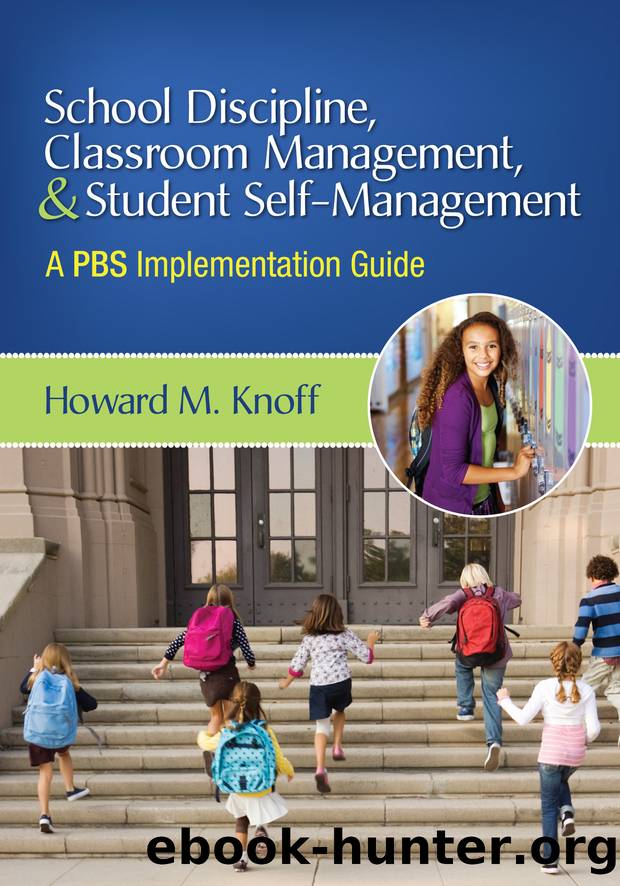School Discipline, Classroom Management, and Student Self-Management by Knoff Howard M.; & Raymond J. McNulty

Author:Knoff, Howard M.; & Raymond J. McNulty
Language: eng
Format: epub
ISBN: 1051669
Publisher: Corwin Press
Published: 2007-08-15T00:00:00+00:00
Environmental Characteristics, Issues, and FactorsâPhysical Plant and Logistics. In general, the problem analysis process here specifically investigates the settings where the inappropriate student behavior is largely occurring, the dynamics and conditions (both positive and negative) within those settings or environments, the logistics whereby students and staff members enter and exit the settings, and how these conditions are contributing to or causing different facets of the problem. Depending on the common school area, this assessment could involve analyses of (a) the physical dimensions, layout, and condition of the setting and the organization of any furniture or equipment; (b) how and how many students and others move into, out of, and within the setting during specific time periods; (c) how students and adults are clustered or organized within the setting, and how many different types (e.g., grade levels) of students are present at different points in time; (d) how quickly students must enter and exit the setting; (e) the student to staff ratios and how supervising staff are organized or deployed within the setting; and (f) other related and relevant factors. Once again, this information is merged with the data from the other domains resulting in a profile of strengths and resources and weaknesses and liabilities within the setting, to go along with the analyses of the reasons for the targeted concerns.
All of the physical plant and logistical characteristics and factors above relate, potentially, to the running, pushing, and shoving problem in our middle school hallway. For example, does the inappropriate behavior occur in hallways that are furthest from the office or instructional (as opposed to elective) classrooms? Does it occur in hallways that are more narrow or crowded than others; that have more disorganized two-way traffic patterns than others; that are closer to different school exits or have more blind turns or corners than others; or that are longer or shorter than others? Clearly, these and other questions try to correlate specific physical plant or logistic factors to the running, pushing, and shoving in the hallway. If the inappropriate behavior occurs regardless of these factors, then the analysis will focus on the other four special situation domains. If the inappropriate behavior occurs in certain parts of the school or due to specific logistical conditions, then these factors need to be addressed during the intervention process.
Incentives and Consequences. Within this domain, it is important to analyze the incentives and consequences that motivate, or could motivate, students and staff to demonstrate appropriate behavior and interactions in the common area of concern or those that reinforce inappropriate behavior. This analysis is done at the individual, group (both peer and adult), and student body and whole-staff levels. It also focuses on the motivational conditions that exist when the problem is occurring or does not occur and that need to exist to resolve and replace the problem in the future.
At the prevention level (see the first section of this chapter), the ultimate question is: âWho or what will motivate everyone in the school to create and
Download
This site does not store any files on its server. We only index and link to content provided by other sites. Please contact the content providers to delete copyright contents if any and email us, we'll remove relevant links or contents immediately.
Macmillan Primary Grammar 2 Pupil's Book by Unknown(400)
Figuring Out Fluency in Mathematics Teaching and Learning, Grades K-8 by Jennifer M. Bay-Williams & John J. SanGiovanni(362)
The Principal's Guide to Curriculum Leadership by Sorenson Richard D.;Goldsmith Lloyd M.;Mendez Zulma Y.;Maxwell Karen T.;(288)
Learning from Accidents 3rd ed by Trevor Kletz (2001)(251)
English Grammar Practice--The Noun by Roxana Nastase(247)
Harnessing Technology for Deeper Learning by Scott McLeod(242)
Text-Dependent Questions, Grades K-5 by Douglas Fisher & Nancy Frey & Heather Anderson & Marisol Thayre(226)
A Guide to Curriculum Mapping by Hale Janet A.;(223)
English Language Program Administration by Unknown(216)
How to Do Everything with Google Tools by Unknown(209)
Deep Change Leadership by Reeves Douglas;(204)
The Grammar Teacher's Activity-a-Day by Jack Umstatter(194)
The Power of SMART Goals by Conzemius Anne;O'Neill Jan; & Anne Conzemius(188)
Beyond the RTI Pyramid by Bender William N.;(170)
Aligning and Balancing the Standards-Based Curriculum by Squires David A.;(169)
Using Data to Close the Achievement Gap by Johnson Ruth S.;(162)
Differentiated Instructional Strategies for the Block Schedule by Gregory Gayle H.;Herndon Lynne E.; & Lynne E. Herndon(161)
Using Equity Audits to Create Equitable and Excellent Schools by Skrla Linda E.;McKenzie Kathryn B.;Scheurich James Joseph;(161)
You've Got to Reach Them to Teach Them by Schreck Mary Kim; & Schreck(154)
